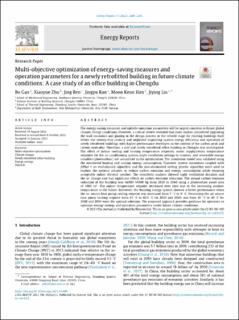| dc.contributor.author | Gao, Bo | |
| dc.contributor.author | Zhu, Xiaoyue | |
| dc.contributor.author | Ren, Jing | |
| dc.contributor.author | Ran, Jingyu | |
| dc.contributor.author | Kim, Moon Keun | |
| dc.contributor.author | Liu, Jiying | |
| dc.date.accessioned | 2023-07-06T11:52:27Z | |
| dc.date.available | 2023-07-06T11:52:27Z | |
| dc.date.created | 2023-01-27T16:08:30Z | |
| dc.date.issued | 2023 | |
| dc.identifier.citation | Energy Reports. 2023, 9 2269-2285. | en_US |
| dc.identifier.issn | 2352-4847 | |
| dc.identifier.uri | https://hdl.handle.net/11250/3076594 | |
| dc.description.abstract | The energy-saving measures and suitable operation parameters will be urgent concerns in future global climate change conditions. However, a critical review revealed that most studies considered upgrading the wall insulation and glazing in the design process or the retrofit stage for existing buildings built before the twenty-first century and neglected improving system energy efficiency and operation of newly retrofitted buildings with higher-performance envelopes in the context of the carbon peak and carbon neutrality. Therefore, a real and newly retrofitted office building in Chengdu was investigated. The effect of indoor cooling and heating temperature setpoints, water supply/return temperature setpoints for the air-conditioning system, night ventilation settings in summer, and renewable energy variables (photovoltaic) are considered in the optimization. The simulation model was validated using the monitored heating and cooling energy consumption. Transient system simulation coupled with jEPlus + an evolutionary algorithm and the non-dominated sorting genetic algorithm were used to explore the optimal solution to reduce carbon emission and energy consumption while ensuring acceptable indoor thermal comfort. The sensitivity analysis showed night ventilation duration and the air change rate had significant effects on carbon emission reduction. The annual carbon emission reduction of the building was 46500–58500 kg from 2030 to 2060 using a photovoltaic panel area of 1000 m2. The indoor temperature setpoint decreased over time due to the increasing outdoor temperature in the future. Moreover, the building energy system showed a better performance when the air source heat pump cooling setpoint was increased from 7 ◦C to 9 ◦C. Decreasing the air source heat pump heating setpoint from 45 ◦C to 42.5 ◦C for 2030 and 2060, and from 45 ◦C to 40 ◦C for 2040 and 2050 were the optimal solutions. The proposed approach provides guidance for operators to optimize energy savings and operation parameters under future climate conditions. | en_US |
| dc.language.iso | eng | en_US |
| dc.rights | Attribution-NonCommercial-NoDerivatives 4.0 Internasjonal | * |
| dc.rights.uri | http://creativecommons.org/licenses/by-nc-nd/4.0/deed.no | * |
| dc.title | Multi-objective optimization of energy-saving measures and operation parameters for a newly retrofitted building in future climate conditions: A case study of an office building in Chengdu | en_US |
| dc.type | Journal article | en_US |
| dc.type | Peer reviewed | en_US |
| dc.description.version | publishedVersion | en_US |
| cristin.ispublished | true | |
| cristin.fulltext | original | |
| cristin.qualitycode | 1 | |
| dc.identifier.doi | ttps://doi.org/10.1016/j.egyr.2023.01.049 | |
| dc.identifier.cristin | 2116909 | |
| dc.source.journal | Energy Reports | en_US |
| dc.source.volume | 9 | en_US |
| dc.source.pagenumber | 2269-2285 | en_US |

